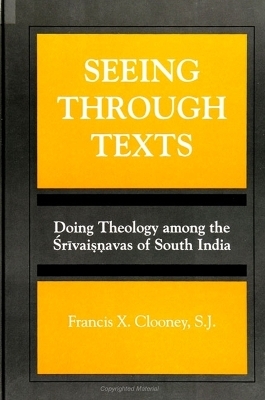
Seeing through Texts
State University of New York Press (Verlag)
978-0-7914-2995-2 (ISBN)
- Titel z.Zt. nicht lieferbar
- Versandkostenfrei innerhalb Deutschlands
- Auch auf Rechnung
- Verfügbarkeit in der Filiale vor Ort prüfen
- Artikel merken
Seeing through Texts invites us into the world of south Indian Hinduism through a study of 100 songs of the Tiruvāymoli, the great masterpiece of the ninth-century Hindu saint Saṭkōpan. These unique songs, dedicated to the Hindu god Viṣṇu/Kṛṣṇa, lead us through poetic and imaginative, philosophical and moral reflections on the nature of the self and the world, ancient myths and temple worship, and the mystical moods of longing, desire, and love in which one seeks, loses, and finds again the God who loves us first. The book is also a study of the interpretation of the Tiruvāymoli in the traditional Hindu Śrivaiṣṇava commentaries of the twelfth-fourteenth centuries, as well as a comparative theological study which explores the implication of the songs and their commentaries for readers from outside the Śrivaiṣṇava tradition.
Francis X. Clooney, S. J. is Professor of Comparative Theology at Boston College. He is the author of Theology after Vedanta, also published by SUNY Press, and of Thinking Ritual.
Foreword
Preface
Chapter One:
Taking a First Look
I. Some Opening Questions
II. Getting Inside Tiruvaymoli
III. Pondering the Author: Sifting the Multiple Contexts
1. Locating Satakopan Historically
2. Finding Satakopan in his Songs
3. Satakopan Under the Tamarind Tree: Learning from
Hagiography
IV. Joining the Conversation: Tiruvaymoli and its Acaryas
1. Introducing the Acaryas and What They Thought
2. The Commentarial Conversation
V. Being a Reader of Tiruvaymoli, Now
1. Comparative, Theological Commitments
2. This Particular Venture: Seeing Christianity and
Srivaisnavism Together
3. This Theologian
VI. Where All of This Leads
Chapter Two:
Getting Inside Tiruvaymoli
I. Listening to the Songs
1. A Dubious Beginning
2. On (Not) Knowing Tamil
II. Thematic Resources
1. Some Major Themes
a. The Transcendent Perfection of God
b. The Gracious Acts of Divine Nearness
c. Holy Places where God Chooses to Dwell
d. The Beauty of God
e. Moral and Religious Appeals
f. Love Songs in an Ancient Genre
g. The Self-Understanding of the Poet
h. Expanding and Exceeding the Described Religious
World
III. Some Formal Components of Tiruvaymoli
1. How the Themes are Located
a. The Litany Effect
b. Form as Frame
2. Antati
3. The Formal Contribution of the Eleventh Verses
IV. Understanding Tiruvaymoli
1. The Direction of the Text
2. Understanding Tiruvaymoli: Reading Across the Text
a. Finding a Context: "Tall One"
b. Finding a Context: "With No Place to Enter, I Have
Entered Right Beneath Your Feet"
c. Finding a Context: Total Surrender
V. Theologizing Tiruvaymoli
1. Boundaries
2. Tiruvaymoli as Map
3. Desire in the Text
a. The Desire to Serve
b. The Desire to See
VI. Reading, Alone or with Others
Chapter Three:
Tiruvaymoli as Meditation, Narrative and Drama: Reading with the Acaryas
I. Satakopan:Anguished Soul, Best of Theologians
1. The Plight of Satakopan
2. The Perfect Theologian
II. The Theological Problem of Vision
1. Ramanuja on the (Indirect) Experience of God
2. The Acaryas' Reading of the Problem of Vision in Tiruvaymoli
a. Looking for God
b. On Not Quite Seeing God: Some Examples
c. Visualization
d. As Near as One Can Get to Vision
III. Tiruvaymoli as Meditation
1. Tiruvaymoli as the Act of Meditation
IV. Tiruvaymoli as Dramatic Narrative
1. The Preliminaries
2. Interpreting the Divine Silence: A Brief Theodicy
3. Resolution and Union
Chapter Four:
Five Ways to Think about Tiruvaymoli Following the Acaryas' Practical Response
I. The First Way: Tiruvaymoli in Correlation with the Three Holy Mantras
1. Smaller Correlations
2. Larger Correlations
3. Correlations with the Whole
II. The Second Way: Tiruvaymoli as a Guidebook to the Right Means to Union with God
III. The Third Way: Satakopan as Exemplar and Teacher of Surrender
1. I.1
2. I.2
3. V.7-10
4. VI.10.10
5. X.4
IV. The Fourth Way: Imagining the Ramayana and Tiruvaymoli as a Moral Scenario
1. Paralleling Tiruvaymoli and the Ramayana
2. Characters in Parallel: The Alvar and his Soulmates
3. Parallel Lives: Satakopan and Laksmana
4. Multiple Dramas, One Ending
V. The Fifth Way: Living Tiruvaymoli in the Community .
VI. On the Threshold of Participation
Chapter Five:
Seeing through Texts: Some Marginal Insights, Presented in Reflections
I. The Prospect from Here
1. What We Have Seen
2. Did the Acaryas Notice Everything?
II. Doing Things with Texts: Composing a Biblio/Biographical Self
1. The Desires of the Song of Songs
2. Encountering the Word in the Gospel According to St. John
3. Travelling the Journey of the Mind to God
4. Working Through the Spiritual Exercises of St. Ignatius Loyola
5. Hans Urs von Balthasar's Prayer
6. Contexts on the Other Side: Mimamsa and Vedanta
7. In Conclusion
III. Learning to See
1. Making Comparisons, Possibly
2. Toward a Systematic Theology—But Not There Yet
3. Telling New Stories: A New Story
4. The End of this Venture: Seeing It Through, Seeing Through It
Notes
Selected Bibliography
Index of Full Verses Cited from Tiruvaymoli
Index of Names and Subjects
| Erscheint lt. Verlag | 3.7.1996 |
|---|---|
| Reihe/Serie | SUNY series, Toward a Comparative Philosophy of Religions |
| Zusatzinfo | Total Illustrations: 0 |
| Verlagsort | Albany, NY |
| Sprache | englisch |
| Maße | 152 x 229 mm |
| Gewicht | 680 g |
| Themenwelt | Geisteswissenschaften ► Religion / Theologie ► Hinduismus |
| ISBN-10 | 0-7914-2995-4 / 0791429954 |
| ISBN-13 | 978-0-7914-2995-2 / 9780791429952 |
| Zustand | Neuware |
| Haben Sie eine Frage zum Produkt? |
aus dem Bereich


